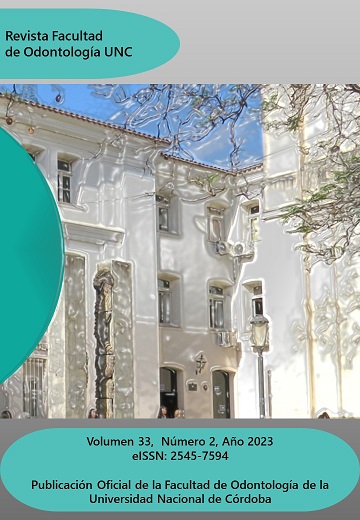Evaluation of an antimicrobial on the adhesion of Candida albicans to denture materials
Keywords:
dental materials, AlphaSan, Candida albicansAbstract
Objective: to evaluate the effect of AlphaSan® on C. albicans adhesion to acrylic and polyamide resins. Methods: 2 x 2 mm squares were made with acrylic resin (AR) and polyamide resin (PR). Four study groups (n=12) were established: Group A: AR without AlphaSan®, Group B: AR with AlphaSan®, Group C: RP without AlphaSan®, Group D: RP with AlphaSan®. All groups were incubated in BHI broth with C. albicans ATCC at 36°C for 48 hours. Quantification of fungal adherence was performed by confocal microscopy (CM) and by means of an aqueous solution of crystal violet (CV), measuring the absorbance at 570 nm. Results: In the quantification of C. albicans adherence with CM, a 50% decrease (p =0.03) was observed between the treated groups (B and D) in relation to those not treated with AlphaSan® (A and C). No significant difference in C. albicans adherence was found between groups B and D (p > 0.5). C. albicans adherence, by CV, decreased by 55% (p= 0.01) in AR with AlphaSan® compared to AR without AlphaSan®. On the other hand, it was observed that fungal adherence decreased by 61% (p=0.01) in RP with AlphaSan® compared to RP without AlphaSan®. No significant difference was observed between the samples treated with the antifungal studied (p >0.05). Conclusion: Fungal adherence to the materials treated with AlphaSan® was limited to 50%, this would be due to the fact that the fungus presents a rigid cell wall (glucans and chitin), which provides a physical barrier for the penetration of different compounds. Consequently, it could be assumed that AlphaSan® would act on the cell wall, which would result in 50% of the fungi being able to adhere to the dental materials.
References
Campbell SD, Cooper L, Craddock H, Hyde TP, Nattress B, Pavitt SH, Seymour DW. Removable partial dentures: The clinical need for innovation. J Prosthet Dent 2017 ;118(3):273-280.
2. Papadiochou S, Polyzois G. Hygiene practices in removable prosthodontics: A systematic review. Int J Dent Hyg 2018;16(2):179-201.
3. Urushibara Y, Ohshima T, Sato M, Hayashi Y, Hayakawa T, Maeda N, Ohkubo C. An analysis of the biofilms adhered to framework alloys using in vitro denture plaque models. Dent Mater J. 2014;33(3):402-14.
4. Chevalier M, Ranque S, Prêcheur I. Oral fungal-bacterial biofilm models in vitro: a review. Med Mycol. 2018; 1;56(6):653-667.
5. Nett JE, Marchillo K, Spiegel CA, Andes DR. Development and validation of an in vivo Candida albicans biofilm denture model. Infect Immun 2010 ;78(9):3650-9.
6. Hellstein JW, Marek CL. Candidiasis: Red and White Manifestations in the Oral Cavity. Head Neck Pathol 2019;13(1):25-32.
7. Lee Muñoz X et al. Ocurrencia de levaduras del género Candida y estomatitis protésica antes y después del tratamiento rehabilitador basado en prótesis removible. Rev Clin Periodoncia Implantol Rehabil Oral 2015; 8(1):31-37.
8. Bertolini M, Ranjan A, Thompson A, Diaz PI, Sobue T, Maas K, Dongari-Bagtzoglou A. Candida albicans induces mucosal bacterial dysbiosis that promotes invasive infection. PLoS Pathog 2019; 22;15(4).
9. Rodríguez Acosta EJ, da Silva PM, Jacobina M, Lara VS, Neppelenbroek KH, Porto VC. Candida albicans adherence to denture base material: chemical disinfection and the effect of acquired salivary pellicle formation. Journal of Prosthodontics 2014; 24:200-206. 10. Vera M M, Pascualini C J y Bojanich M A. Evaluación Microbiológica de Mangueras de Equipos Odontológicos tratadas con un Bacteriostático. Rev Fac Odont 2020; 30 (2) 47- 49.
Vera et al. RevFacOdont 33(2)2023
8
11. Aslanimehr M, Rezvani S, Mahmoudi A, Moosavi N. Comparison of Candida Albicans Adherence to onventional Acrylic Denture Base Materials and Injection Molding Acrylic Materials. J Dent (Shiraz) 2017;18(1):61-64. 12. Atriwal T, Azeem K, Husain FM, Hussain A, Khan MN, Alajmi MF, Abid M. Mechanistic Understanding of Candida albicans Biofilm Formation and Approaches for Its Inhibition. Front Microbiol 2021;30-40. 13. Sato M, Ohshima T, Maeda N, Ohkubo C. Inhibitory effect of coated mannan against the adhesion of Candida biofilms to denture base resin. Dental Materials Journal 2013; 32(3): 355–360. 14. Pereira R, Dos Santos Fontenelle RO, de Brito EHS, de Morais SM . Biofilm of Candida albicans: formation, regulation and resistance. J Appl Microbiol 2021;131(1):11-22. 15. Holmes AR, Rodrigues E, van der Wielen P, Lyons KM, Haigh BJ, Wheeler T, Dawes PJD, Cannon RD. Adherence of Candida albicans to silicone is promoted by the human salivary protein SPLUNC2/PSP/BPIFA2. Mol Oral Microbiol 2014;29(2):90-8. 16. Koch C, Bürgers R, Hahnel S. Candida albicans adherence and proliferation on the surface of denture base materials. Gerodontology. 2013; 30(4):309-13. doi: 10.1111/ger.12056. 17. Gow Neil AR , Latge Jean-Paul , Munro CA. The Fungal Cell Wall: Structure, Biosynthesis, and Function. Microbiol Spectr 2017;5(3). 18. Manzon L, Fratto G, Poli O, Infusino E. Patient and Clinical Evaluation of Traditional Metal and Polyamide Removable Partial Dentures in an Elderly Cohort. J Prosthodont 2019;28(8):868-875
Downloads
Published
Issue
Section
License

This work is licensed under a Creative Commons Attribution-NonCommercial-ShareAlike 4.0 International License.
Aquellos autores/as que tengan publicaciones con esta revista, aceptan los términos siguientes:
- Los autores/as conservarán sus derechos de autor y garantizarán a la revista el derecho de primera publicación de su obra, el cuál estará simultáneamente sujeto a la Licencia de reconocimiento de Creative Commons que permite a terceros:
- Compartir — copiar y redistribuir el material en cualquier medio o formato
- La licenciante no puede revocar estas libertades en tanto usted siga los términos de la licencia
- Los autores/as podrán adoptar otros acuerdos de licencia no exclusiva de distribución de la versión de la obra publicada (p. ej.: depositarla en un archivo telemático institucional o publicarla en un volumen monográfico) siempre que se indique la publicación inicial en esta revista.
- Se permite y recomienda a los autores/as difundir su obra a través de Internet (p. ej.: en archivos telemáticos institucionales o en su página web) después del su publicación en la revista, lo cual puede producir intercambios interesantes y aumentar las citas de la obra publicada. (Véase El efecto del acceso abierto).

